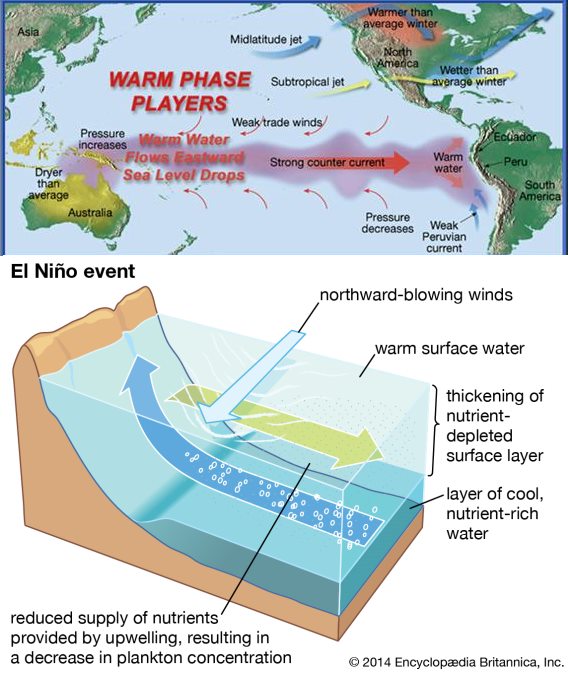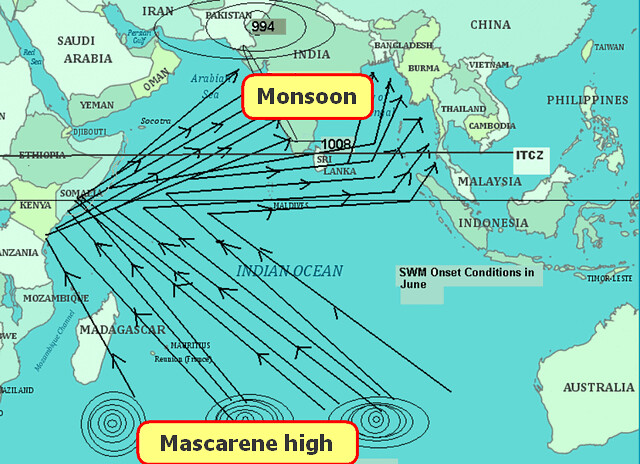UPSC General Studies (Mains) – Answer following in 200 words each.
- (GS1) What is El Nino? How does it affect India and World?
- (GS1) Explain in brief, the impact of La Nina on Indian monsoon
- (GS3) Discuss the structure and functions of Biodiversity Management Committees under Biodiversity Act 2002? Evaluate their success in India.
Interview
- The fear about El Nino on Indian Economy is overhyped. Do you agree?
What happens in a Normal Year?
- Peru Current = Humboldt Current = Cold Current.
- During normal year two things are “STRONG”
- Cold Peru Current
- Trade Winds
- As a result, cold water is dragged from Peru towards Australia. (observe following image)
Result of this exchange?
- In above image, the red (warm) water region around Australia is called Western Pacific Pool (WPP)
- WPP = low pressure = warm air ascends = cloud formation = rain over North Australia
- This air also joins walker cell and begins descending near Peru.
- Descending air = anti-cyclonic condition = high pressure = stability = no cloud/rain = Drought in Atacama Desert.
So in a way two cycles are created
| below the water | Moving of water from Peru to Australia. | @Peru cold water upwelling brings nutrient to surface= more lunch for Plankton= more fishes = good for Peru fishermen. |
| above water | Moving of air from Australia towards Peru. | Warm water + low atmospheric pressure = good rainfall over Australia & Indonesia. |
Ok, we learned what happens in Normal year. Now let’s check
What happens in La Nina Year?
same things as in a “normal” year, but those two things become even “stronger”
- Cold Peru Current
- Trade Winds
Result?
- Too many fishes @Peru coast, oversupply of fishes= prices become dirt cheap
- Too much rain / flood over Australia and Indonesia.
Now coming to the main topic:
What happens in an El Nino year?
- two things become “WEAK”
- Cold Peru Current
- Trade Winds
- As result, cold water is not dragged from Peru to Australia.
- But reverse happens – warm water is dragged from Australia towards Peru.
- Consequently, warm water + low pressure condition develops in the Eastern Pacific (Peru) and Cold condition + high pressure in Western Pacific (Australia).
Since Pressure is inversely related with amount of rainfall, the results are following
- Rain & Floods @Peru, Atkama and even Southern USA
- Drought @Northern Australia, Indonesia- even bushfires.
- Storms and Hurricanes in East Pacific.
- Coral bleaching (high temperature coral dies)
- (for MCQ) El Nino decreases earth’s rotation rate, decreases Coriolis force and increases length of day. (La Nina creates opposite). How? Because El Nino changes the wind pattern, hence Earth needs change speed to conserve its angular momentum of Earth-Atmospheric system.
What is El Nino?
- Warming of Pacific Ocean
- Near Western coast of Peru and Ecuador.
- Occurs @every 3-4 years; [In theory, it should occur @every 12 years].
- Its impact usually lasts for 9-12-18-24 months.
- It weakens the trade winds and changes in Southern Oscillation, thereby affects the rainfall pattern across the world.
What is Southern Oscillation?
- Alternating of (tropical) sea level pressure
- Between the eastern and western hemispheres.
We measure Southern Oscillation by observing the pressure difference between
- Tahiti (French Polynesia) and
- Darwin (Australia).
Impact of Southern Oscillation (SO)?
| Low Index | High SO |
| Higher pressure difference |
| associated with El Nino hence the name ENSO = El Nino-Sothern Oscillation | La Nina |
| Weak trade winds | Strong trade winds |
| poor monsoon | good monsoon |
How does El Nino affect Indian Monsoon?
- El Nino-Southern Oscillation (ENSO) water circulation happens between Australia and Peru
- But the wind movement is part of larger atmospheric circulation hence affects the rainfaill over India. But how?
We learned that During normal year, the warm water moves towards Australia, this pool of warm water is called Western Pacific Pool (WPP). From WPP air rises above and moves towards two walker cells
- Towards Peru coast = this affects rainfall in South America.
- Towards Mascarene High Pressure zone near East Africa. = This affect Indian monsoon.
| DURING NORMAL YEAR | DURING EL NINO YEAR |
|
|
| During La Nina years, this push is even stronger = heavy rain and floods. |
|
El Nino= Little boy in Spanish. Hence its opposite is called
|
|
El Nino 2014 and India
- India Meteorological Department (IMD) has predicted “below” normal monsoon for 2014.
- RBI Governor Raghuram Rajan too has warned about the negative impact of El Nino
- Poor monsoon / drought like condition = commodities prices will rise especially sugar, pulses and edible oil. Government needs to stock them up, put restriction on exports, before black marketers start hoarding.
- Farmers need to device alternate farming strategy, change the seeds and irrigation strategy for the drought like situation.
| NEED TO WORRY | DON’T NEED TO WORRY |
|
|
|
|
Will El Nino 2014 hurt Indian GDP?
Merrill Lynch predicated following:
| 2014 (without El Nino) | 2014 with El Nino |
| good rainfall | poor rainfaill / drought like condition |
| inflation declines to ~7% | inflation raises to ~10% |
| if inflation declines=> RBI will reduce repo rate=>cheaper loans=>more business expansion =>more GDP. | To combat inflation, RBI will further increase REPO rate (OR RBI will not decrease REPO Rate) => either way expensive loans => less business expansion => low GDP growth. |
GDP growth rate will increase
| low GDP growth rate
|
Do we really need to fear El Nino 2014?
answer is both YES and NO.
Arguments: why we don’t need to fear El Nino:
- Only “Strong” El Nino affects India negatively. But this time WMO predicted “Weak” El Nino.
- Private Weather Agencies predict only 30% chance of El nino.
- Not Every El Nino year caused drought in India in the past.
- Under British Raj and even in 50s era, a drought under El Nino = Millions would die in starvation and suicide because of moneylenders.
- But that’s not the same India we live in today. ~40% of the farmlands are irrigated; FCI has large buffer stock of foodgrains; Government has sufficient money to announce financial packages to drought hit farmers; RBI has sufficient Forex reserve to finance any emergency food imports; we enjoy goodwill among all developed countries for even food-aid free of cost.
- Only IF terrorists blowup all FCI godowns, Black maketeers hoard every last gram of remaining onions and foodgrains, RBI’s forex reserve gets completely empty because of Fed Tapering…..THEN and only THEN El Nino can create havoc on India.
- El Nino Southern Oscillation = natural phenomenon for redistribution of excess heat. Humans cannot control or modify this cycle. In theory we can stop El Nino by dropping 10m thick iceberg size of a United States, into the Peru coast- but that’s impractical. So, Instead of fearing El Nino, we must learn to predict and adapt to its consequences.
Arguments: why we should worry about El Nino 2014
- Even if El Nino doesn’t happen, the mere rumor of El Nino drives up the prices in commodity market because of the speculative investors. For example, global prices of Cocoa are high right now- not because of less production but because of El Nino speculation.
- It is true we enjoy good will among developed countries for getting free food aid. But this time,
- Australia- second largest export of wheat they’re already facing drought because of Pre-El Nino type condition.
- US Midwest =called “Granary of the world” for wheat and corn. But they too face flood danger from El Nino.
- India is second largest producer of sugar, rice and wheat in the world. 90% of Rice comes from Asia.
Erratic Rainfall, melting of Himalayan glaciers, frequent flooding, draughts, storms and cyclones => Food insecurity for large population.
- United Nations’ World Meteorological Organization predicted a “weak” El Nino by the middle of 2014.
- It depends on when exactly during “mid” 2014 this happens because
| IF El Nino happens by summer | IF El Niño happens by fall season (August to October.) |
| Then India will be worst affected because of low monsoon during June- September. | Then India will escape without injuries. |
Economic Survey Points on El Nino
What is El-Nino?
- El Niño effect occurs when surface temperatures in the Pacific Ocean continuously rise above average for several months, which in turn adversely affects weather in many parts of the world.
- El Nino occurs every 3-5 years.
- South-west (SW) monsoon (from June to September) accounts for ~75% rainfall. Any shortage here.
- El Nino often begins to form during June-August, and typically lasts 9-12 months.
Where India should worry?
El Nino’s impact will be felt the most at…
- rainfed regions of central, south, and north-west India
- Maharashtra, Gujarat, Rajasthan, Karnataka, Jharkhand, and Bihar.
- rice, soybean, cotton, maize, jowar, groundnut, and sugarcane will be affected.
- kharif pulses and oilseed
Why India shouldn’t worry?
- While the majority of drought years in India coincide with the occurence of the El Niño, the reverse link is not that strong. (meaning, El nino doesn’t always lead to Drought)
- For example, in 1997, when the impact of El Niño was reported to be the worst, India had 2 per cent higher than normal rainfall
- In the past decade, the El Niño occurred in 2002, 2004, 2006, and 2009
- But 2002-03 was the only year that India showed negative agri sector growth with average rainfall dropping 20 per cent below normal.
- The last four occurrences of El Niño reveals that the impact was more in the kharif season.
- Government has placed contingency measures in about 500 districts.
- Central Water Commission (CWC) reflect a better status of water availability.





No comments:
Post a Comment